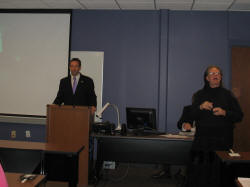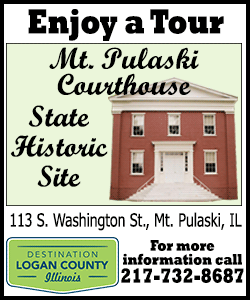|

On Sunday, April 12, 2015, The Lincoln Heritage Museum in
conjunction with Logan County Genealogical and Historical Society
held a program commemorating that sad time in our nation’s history.
The program opened with a small band playing “New Beginnings, a
musical prelude composed by LC student Allie Miller, which drew from
Lincoln’s funeral and his journey back to Illinois.

Chuck Fricke provided narration of the life and times of Abraham
Lincoln up until his death based on writings by Paul Gleason. He
quizzed the audience with several trivia questions about Lincoln’s
life and circumstances of his death throughout the program. Fricke
noted that Abraham Lincoln helped bring us to where we are today.
Lincoln’s law partner William Herndon described him as “a little
engine that never rests.”

Fricke gave a brief history of Lincoln's life from his humble
beginning in Kentucky to the funeral procession that would travel
through seven states. He asserted that life on the frontier was
difficult for Lincoln but it gave him the strength, courage, and
confidence that would serve him well later in life.
Fricke said Lincoln saw the years in New Salem from 1831-1837 as a
time of failure. It was during his years in Springfield, his work
with law partners Stuart, Logan, and Herndon who taught him about
law and politics, and where he made many friends who helped spur his
political career. Fricke explained that these years helped
established his future and taught him the thinking habits and
beliefs of the common man.
Lincoln’s presidency began as the nation was on the brink of
collapse and he said that states should not secede, for he hoped to
save the union. The years of civil war caused a divided nation and
though he freed the slaves with his Emancipation Proclamation, many
had become disheartened by the fight against slavery.
By the time the funeral train travelled through the country, though,
Lincoln was seen as a President who “belonged to the ages.”
Fricke ended his portion of the program by unveiling a picture of
the funeral procession that portrayed two men guarding Lincoln’s
casket.

Museum director Ron Keller shared “The Final Journey: An Imagined
News Coverage of Lincoln’s Funeral Procession.” Keller researched
photos and newspaper coverage from that time and presented the
information as if might have been shown if there had been television
news. Keller began by sharing details of Lincoln’s assassination and
the moments immediately after as they carried him to a nearby
boarding house and his family and cabinet members gathered at his
bedside until he breathed his last breath around 7:00 a.m. on April
15.
[to top of second column] |

Keller reported that many businesses closed as the nation came to
a standstill, spectators gathered in front of the White House for a
week as nearly 25,000 mourners lined up to pay their respect, and
his close friend Reverend Gurley performed the funeral.
Keller commented that thousands gathered to watch the funeral
procession and people waited for hours as the funeral train
travelled the 1,700 miles to Springfield.
Funeral activity overwhelmed New York, and many activities in Ohio
came to a standstill. Keller asserted that the funeral in Chicago
was even more somber since many people there knew him and people
lined up for over 12 hours to see the body. Along the final route to
Springfield, people waved banners with messages such as “Welcome
home.”
Keller recounted that on May 3 the train returned to Springfield,
the town where Lincoln owned his first home and he had known almost
everyone by name. Keller stated that Lincoln lay in state in the
Hall of Representatives as many lined up to say goodbye, but the
largest spectacle occurred as the final procession passed through
the train to his final resting place at Oak Ridge Cemetery.
The next presentation on Sunday was a dramatic portrayal by Alexa
Maxey playing the role of Louisa Hawes, reading Hawes’s letter to
her brother detailing Lincoln’s assassination.
For the procession through Atlanta, Illinois, black banners were
draped saying “Rest in peace.” Hawes poured out her feelings and
reported that their hearts ached as the train passed through, but
she felt people should be pious and determined as ever.
As the program drew to a close, Lincoln historian Paul Beaver told
of the long journey to Springfield and proudly noted that his
grandparents viewed the procession through Lincoln. Beaver shared
that problems occurred as a group in Springfield decided where to
bury Lincoln spending the then exorbitant amount of $50,000 to
$60,000, but his wife Mary rejected the location they had chosen.
The funeral in Springfield was the 20th one, and 150,000 people
attended with many of them leaving work to attend.

Beaver recounted that in 1876 there was a plot to steal Lincoln’s
body, but it was not successfully carried out. By 1901, his son
Robert decided the tomb needed to be renovated and made more secure.
Deciding to make sure the body in the coffin was indeed Abraham
Lincoln, 23 people, including a young boy, viewed his face one last
time, agreeing that it was definitely Lincoln.
In the first town named for Abraham Lincoln, the people have not
forgotten this great man. The man of humble beginnings - a store
keeper, surveyor, circuit rider lawyer in Logan County, state
legislator - who rose to become our 16th President, the one to save
our country from splitting; an inspiration then and still through
the centuries.
[Angela Reiners] |